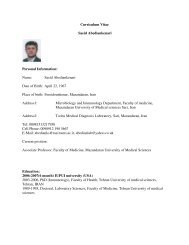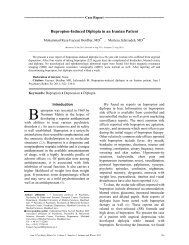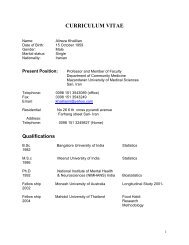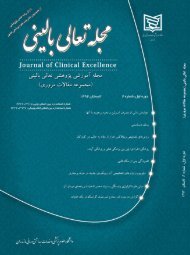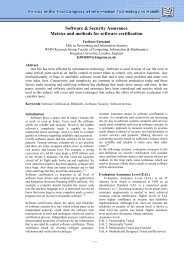08= Keyvanara - Iranian Journal of Psychiatry and Behavioral ...
08= Keyvanara - Iranian Journal of Psychiatry and Behavioral ...
08= Keyvanara - Iranian Journal of Psychiatry and Behavioral ...
Create successful ePaper yourself
Turn your PDF publications into a flip-book with our unique Google optimized e-Paper software.
Original Article <br />
Suicide Prevention: The Experiences <strong>of</strong><br />
Recurrent Suicide Attempters (A phenomenological study)<br />
Mahmoud <strong>Keyvanara</strong>, MD • * , Seyed Ghafur Mousavi, MD*<br />
Azadeh Malekian, MD* , Masoud Kianpour, MSc**<br />
(Received: 3 July 2009; Accepted: 1 February 2010)<br />
___________________________________________________________________________________________<br />
Objective: Presently, the issue <strong>of</strong> attempted suicide now poses one <strong>of</strong> the major challenges facing the healthcare<br />
providers in Iran <strong>and</strong> other countries. Although in previous years, the number <strong>of</strong> people entering to hospital<br />
emergency departments after deliberately taking overdoses or injuring themselves has been steadily increased in<br />
Iran, however, there is less attention to the issue <strong>of</strong> suicide prevention. The main aim <strong>of</strong> this study is to<br />
underst<strong>and</strong> the experiences <strong>of</strong> those who re-attempted suicide, along with regarding suicide prevention.<br />
Methods: A qualitative phenomenological approach was applied. Purposeful samples <strong>of</strong> 12 patients who had<br />
a history <strong>of</strong> attempted suicide <strong>and</strong> were able to attend <strong>and</strong> respond to questions were recruited. Data was<br />
gathered by means <strong>of</strong> an in-depth semi-structured interview with each subject separately. The analysis <strong>of</strong> the data<br />
was conducted using the phenomenological analytic method defined by Colaizzi.<br />
Results: Over all, 667 descriptive codes were extracted, which were later reduced to 36 interpretative codes<br />
<strong>and</strong> then to 8 explanatory codes. Finally, four fundamental constructs <strong>of</strong> structural factors, personal factors,<br />
caring institutions <strong>and</strong> social networks were identified.<br />
Conclusion: The experiences <strong>of</strong> the participants showed that although individual factors are important <strong>and</strong><br />
could influence suicide prevention, the structural <strong>and</strong> socio-cultural contexts which are out <strong>of</strong> individuals control<br />
are significant as well.<br />
Declaration <strong>of</strong> interest: None.<br />
<strong>Iranian</strong> <strong>Journal</strong> <strong>of</strong> <strong>Psychiatry</strong> <strong>and</strong> <strong>Behavioral</strong> Sciences (IJPBS), Volume 4, Number 1, Spring <strong>and</strong> Summer 2010: 4-12.<br />
Keywords: Recurrence • Suicide Attempt •Suicide Prevention<br />
•Introduction<br />
S<br />
uicide is a prevailing problem across<br />
the world <strong>and</strong> is one <strong>of</strong> the first 10<br />
causes <strong>of</strong> death (1). According to<br />
estimations from World Health Organization<br />
(WHO), approximately one million died in<br />
year 2000 across the world, due to suicide (1).<br />
It has significant consequences for individuals<br />
including severe mental <strong>and</strong> physical disorders,<br />
long-term disabilities, <strong>and</strong> eventually, death (2),<br />
as well as negative effects on society at large,<br />
<strong>and</strong> environment, family, <strong>and</strong> the health care<br />
system. Suicide ideation is a complicated<br />
behaviour, beginning from thoughts <strong>of</strong> suicide<br />
Authors' affiliation : * <strong>Behavioral</strong> Sciences Research Center,<br />
Isfahan University <strong>of</strong> Medical Sciences, Isfahan, Iran; <strong>and</strong> Memorial<br />
University <strong>of</strong> Newfoundl<strong>and</strong>, Canada.<br />
•Corresponding author : Mahmoud <strong>Keyvanara</strong>, MD, Assistant<br />
pr<strong>of</strong>essor <strong>of</strong> sociology, Health Humanities Research Center, Isfahan<br />
University <strong>of</strong> Medical Sciences, Isfahan, Iran.<br />
Tel: +98 311 6684799<br />
Fax: +98 311 6684799<br />
E-mail: keyvanara@mng.mui.ac.ir<br />
to suicidal behaviour, followed by suicide<br />
attempt, in which, in some cases, leads to<br />
death (3). To reduce suicide rates, various<br />
strategies are applicable in terms <strong>of</strong> suicideprevention<br />
strategies. These strategies should<br />
be designed in such a way that they include<br />
not only psychological factors, but contextual,<br />
social, <strong>and</strong> national variables as well (4).<br />
Recently, the rates <strong>of</strong> suicide have been<br />
increasing in Iran <strong>and</strong>, at the same time, the age<br />
in which people committing suicide has been on<br />
a decline trend (5). It is also more widespread<br />
among <strong>Iranian</strong> women than men (6,7). The<br />
prevalence <strong>of</strong> suicide was calculated to be 9.4<br />
in 100,000 in this country (8). In spite <strong>of</strong> these<br />
statistics, it appears it is still not viewed as a<br />
social <strong>and</strong> threatening problem. Few studies<br />
have been conducted regarding suicide prevention<br />
in Iran to propose practical strategies based on<br />
<strong>Iranian</strong> culture. Study <strong>and</strong> research in the<br />
developing countries, however, suggest that<br />
for a comprehensive underst<strong>and</strong>ing <strong>of</strong> suicide<br />
<strong>Iranian</strong> <strong>Journal</strong> <strong>of</strong> <strong>Psychiatry</strong> <strong>and</strong> <strong>Behavioral</strong> Sciences (IJPBS), Volume 4, Number 1, Spring <strong>and</strong> Summer 2010 4
<strong>Keyvanara</strong> M , Mousavi S.Gh , Malekian A , et al.<br />
<strong>and</strong> suicide prevention, it is beneficial to<br />
apply qualitative approaches (9), emphasising<br />
the subjective <strong>and</strong> interpretative underst<strong>and</strong>ing<br />
<strong>of</strong> suicide (10). Qualitative approaches were<br />
developed as a response <strong>and</strong> critique to<br />
Durkheim’s theory <strong>of</strong> suicide (11) to specifically<br />
address issues such as suicide definition,<br />
culture <strong>of</strong> suicide (10), suicide meaning (12)<br />
<strong>and</strong> actor intention (13).<br />
This paper seeks to explore experiences <strong>of</strong><br />
recurrent suicide attempters regarding suicide<br />
prevention. The qualitative methodology is<br />
applied to obtain a comprehensive underst<strong>and</strong>ing<br />
<strong>of</strong> the actual experiences <strong>of</strong> suicide attempters.<br />
Materials <strong>and</strong> Methods<br />
This research applied a qualitative method<br />
within the phenomenological approach. A<br />
purposeful sample was recruited. Sampling<br />
continued until data saturation, namely, that<br />
no new conceptual patterns were emerging (14).<br />
Semi-structured, in-depth interviews were<br />
conducted with twelve individuals who have<br />
attempted suicide previously <strong>and</strong> were admitted<br />
to Nour Hospital in Isfahan (Iran), during the<br />
year <strong>of</strong> 2007. Cases were available by two<br />
ways. First, individuals who had a history <strong>of</strong><br />
suicide attempt in their medical records at the<br />
poison ward or psychiatric ward. They<br />
comprised <strong>of</strong> eight individuals who were<br />
invited for the interviews. Meanwhile, the<br />
research team identified <strong>and</strong> invited four other<br />
individuals whom recently attempted suicide<br />
<strong>and</strong> were institutionalized in a psychiatric<br />
ward. Those volunteers that were selected,<br />
who had attempted committed suicide at least<br />
two times, <strong>and</strong> who declared themselves willing<br />
<strong>and</strong> who were capable <strong>of</strong> talking about their<br />
experiences. The participants’ medical reports<br />
were checked to ensure they are not suffering<br />
from acute psychosis, intense depression or<br />
bipolar disorder. Patients who had anti-social<br />
behaviour <strong>and</strong> those who were not able to<br />
complete the interview process were excluded.<br />
Enough time was allocated for establishing<br />
an appropriate relationship between participants<br />
<strong>and</strong> researchers. The interviews were conducted<br />
at the Nour Hospital, in a calm <strong>and</strong> suitable<br />
environment. Consent was taken prior to taking<br />
before commencing interviews. An interview<br />
check list was used to guide the interview<br />
process. The interview time ranged from 30 to<br />
70 minutes each. They were recorded <strong>and</strong><br />
transcribed verbatim. Conversations were<br />
recorded to ensure that emotionally-charged<br />
words <strong>and</strong> sentences could be distinguished<br />
<strong>and</strong> set apart by highlighting them in the text.<br />
To make ensure <strong>of</strong> the authenticity <strong>of</strong> the data<br />
<strong>and</strong> the validity <strong>of</strong> the results, data was<br />
presented to the participants <strong>and</strong> necessary<br />
corrections were made. Research team<br />
participated in all activities to enhance<br />
reliability. The data was analyzed according<br />
to Coaizzi’s seven-stage method (15), a method<br />
especially suitable for phenomenological<br />
studies. First, the texts were carefully read<br />
to obtain a complete <strong>and</strong> comprehensive<br />
underst<strong>and</strong>ing <strong>of</strong> the ideas, experiences, <strong>and</strong><br />
opinions <strong>of</strong> the participants. Then, words <strong>and</strong><br />
sentences relevant to suicide prevention were<br />
noted. In the third stage, the researchers<br />
spelled out the meanings <strong>of</strong> each significant<br />
sentence by categorizing them into groups.<br />
The following narrative provides an example<br />
<strong>of</strong> how a code called “disability in doing daily<br />
routines” is extracted from an interview:<br />
When I realized I can’t read like before, I<br />
was disappointed. I couldn’t do anything,<br />
even things like speaking. I couldn’t talk like<br />
before. I was a talkative person - you know-,<br />
but not now. I could be very successful in<br />
sports…. I was a member <strong>of</strong>…. (Interview<br />
No. 1).<br />
In the next stage, after combining repetitive<br />
codes <strong>and</strong> developing new categories, 667<br />
codes were extracted in terms <strong>of</strong> clusters <strong>of</strong><br />
topics. These clusters are referred to as<br />
descriptive codes (sub-concepts <strong>of</strong> the third<br />
level) or codes close to the actual terms used<br />
by the participants. Descriptive codes provided<br />
a detailed <strong>and</strong> exhaustive description <strong>of</strong> the<br />
phenomenon in the four categories around<br />
which the research revolves. From these<br />
codes, a new set <strong>of</strong> codes were generated;<br />
referred to as interpretive codes (or subconcepts<br />
<strong>of</strong> the second level) which include<br />
the meaning <strong>and</strong> interpretation <strong>of</strong> previous<br />
codes. Overall, descriptive codes were reduced<br />
to 36 interpretative codes (12 codes attentive<br />
to attempted suicide <strong>and</strong> 24 codes attentive to<br />
5<br />
<strong>Iranian</strong> <strong>Journal</strong> <strong>of</strong> <strong>Psychiatry</strong> <strong>and</strong> <strong>Behavioral</strong> Sciences (IJPBS), Volume 4, Number 1, Spring <strong>and</strong> Summer 2010
Suicide Prevention<br />
suicide prevention). Finally, <strong>and</strong> for explanatory<br />
purposes, interpretative codes were reduced<br />
into 8 explanatory codes (or sub-concepts <strong>of</strong><br />
the first level) to summarize <strong>and</strong> explain the<br />
coding process. The resulting structure is<br />
constituted <strong>of</strong> two categories: (1) contexts <strong>of</strong><br />
attempted suicide <strong>and</strong> (2) context <strong>of</strong> suicide<br />
prevention. By combining all codes, four<br />
fundamental constructs were generated. A<br />
final evaluation <strong>and</strong> validation was achieved<br />
by returning to participants <strong>and</strong> asking about<br />
the findings.<br />
Results<br />
The youngest <strong>and</strong> the oldest were 16 <strong>and</strong><br />
50 years <strong>of</strong> age, respectively. Four participants<br />
were women, while eight were men. Educational<br />
levels ranged from associate degree, to below<br />
high-school diploma. Five participants were<br />
married, six were single <strong>and</strong> one was divorced.<br />
The majority <strong>of</strong> the participants were unemployed.<br />
The least suicide attempts were two <strong>and</strong> the<br />
most were four. The majority <strong>of</strong> the participants<br />
were not drug abusers. The common methods<br />
used to commit suicide included drug overdose,<br />
hanging, gas poisoning, cutting vein <strong>and</strong><br />
jumping. Participants who took an overdose<br />
were provided by buying their drugs personally<br />
from drug stores. A few <strong>of</strong> the participants<br />
decided on their suicide method by watching<br />
movies <strong>and</strong> gleaning information provided by<br />
media or books. One <strong>of</strong> the participants, for<br />
example, decided on his suicide method as<br />
follows:<br />
…. I read this book about the story <strong>of</strong> that<br />
important guy whose wrist vein was cut in the<br />
bathroom… I learned from that…. (Interview<br />
No.12)<br />
Figure 1 shows conceptual levels (interpretative<br />
<strong>and</strong> explanatory codes) <strong>of</strong> contexts <strong>of</strong> suicide<br />
attempts. Most <strong>of</strong> the participants committed<br />
their suicide within the family contexts, <strong>and</strong><br />
personal <strong>and</strong> socio-economic contexts. The<br />
main interpretative codes were constituted by<br />
family problems.<br />
Figure 2 shows contexts <strong>of</strong> suicide<br />
prevention. Contexts <strong>of</strong> suicide prevention are<br />
categorized in five explanatory codes including<br />
'self-caring', 'medical care', 'psychological care<br />
<strong>and</strong> consulting', 'social interactions affected to<br />
suicide prevention' <strong>and</strong> 'socio-economic<br />
contexts'. Each explanatory code is derivative<br />
from different interpretative codes.<br />
Figure 3 shows the inter-relationship between<br />
contexts <strong>of</strong> suicide attempts <strong>and</strong> contexts <strong>of</strong><br />
suicide prevention. It should be noted that the<br />
experience comes from the combination <strong>of</strong><br />
explanatory codes attentive to suicide attempt<br />
<strong>and</strong> suicide prevention, constituting four<br />
fundamental constructs <strong>of</strong> structural, personal,<br />
<strong>and</strong> caring factors as well as social networks.<br />
Contexts <strong>of</strong> suicide attempt<br />
Socio-economic contexts<br />
Individual factors<br />
Family contexts<br />
Sub- concept<br />
at the first level<br />
(explanative<br />
codes)<br />
Economic context<br />
Social interactions<br />
Self-attitude<br />
Disability in problem solving<br />
Performance before suicide attempt<br />
In-law friction<br />
Sibling frictions<br />
Father- son friction<br />
Mother- daughter friction<br />
Father-daughter friction<br />
Wife-husb<strong>and</strong> friction<br />
Family disorder<br />
Sub-concept at the second level<br />
(interpretative codes)<br />
Figure 1. Conceptual levels (interpretative <strong>and</strong> explanative codes) <strong>of</strong> contexts <strong>of</strong> suicide attempt<br />
<strong>Iranian</strong> <strong>Journal</strong> <strong>of</strong> <strong>Psychiatry</strong> <strong>and</strong> <strong>Behavioral</strong> Sciences (IJPBS), Volume 4, Number 1, Spring <strong>and</strong> Summer 2010 6
<strong>Keyvanara</strong> M , Mousavi S.Gh , Malekian A , et al.<br />
Contexts <strong>of</strong> suicide prevention<br />
Social interaction affected to suicide prevention<br />
Medical care<br />
Socio-economic contexts<br />
Psychological care <strong>and</strong> consulting<br />
Self-caring<br />
Sub-concept at<br />
the first level<br />
(explanative<br />
codes)<br />
Proper relation with doctor<br />
Consulting with doctor <strong>and</strong> psychiatrist<br />
Improvement in doctor-patient relations<br />
Access to doctor<br />
Permanent medical therapy<br />
Medical therapy<br />
Interaction with others, (relatives,<br />
significant others, <strong>and</strong> …)<br />
Economic contexts<br />
Family Interactions<br />
Change in life conditions<br />
Entertainment <strong>and</strong><br />
recreation<br />
Self-control over suicide thought<br />
Visiting psychiatrist <strong>and</strong> instant consulting<br />
Optimizing<br />
Self-actualization<br />
Interactional self-control<br />
Self- inculcation<br />
Improvement in the quality <strong>of</strong> psychological consulting<br />
Cultural contexts<br />
Priority <strong>of</strong> consulting to<br />
medicine<br />
Lay-consulting<br />
Psychological consulting<br />
Holistic consulting<br />
Skillfulness in<br />
consulting<br />
Sub-concept at the second level<br />
(interpretative codes)<br />
Figure 2. Conceptual levels (interpretative <strong>and</strong> explanatory codes) <strong>of</strong> context <strong>of</strong> suicide prevention<br />
Experiences <strong>of</strong> suicide-prevention<br />
Caring institutions<br />
Social networks<br />
Structural factors<br />
Personal factors<br />
Fundamental<br />
structures<br />
Medical care<br />
Psychological care <strong>and</strong> consulting<br />
Family contexts <strong>of</strong> suicide attempt<br />
Self-caring<br />
Individual factors<br />
<strong>of</strong> suicide attempt<br />
Social interaction affected to suicide<br />
prevention<br />
Socio-economic contexts <strong>of</strong><br />
suicide prevention<br />
Socio-economic contexts<br />
<strong>of</strong> suicide attempt<br />
The first level concepts <strong>of</strong> the contexts <strong>of</strong><br />
suicide prevention <strong>and</strong> attempt<br />
(explanative codes)<br />
Figure 3. Interrelationship between suicide attempts <strong>and</strong> suicide prevention<br />
7<br />
<strong>Iranian</strong> <strong>Journal</strong> <strong>of</strong> <strong>Psychiatry</strong> <strong>and</strong> <strong>Behavioral</strong> Sciences (IJPBS), Volume 4, Number 1, Spring <strong>and</strong> Summer 2010
Suicide Prevention<br />
Structural factors<br />
Abstract concepts in the context <strong>of</strong> suicide<br />
attempt that are generated from themes in the<br />
interviews include low economic situation<br />
<strong>and</strong> societal anomies. The internal interplay <strong>of</strong><br />
these two factors is <strong>of</strong> curial importance.<br />
Inadequate economic situation stems from<br />
unemployment, financial problems <strong>and</strong> lack<br />
<strong>of</strong> proper housing situation. One <strong>of</strong> the<br />
participants explains:<br />
I am jobless now. I worked in the city<br />
council for one year. I had a job there. I went<br />
to free market; one day you could get the job,<br />
one day you couldn’t. Then I went. … They<br />
said bring a recommendation letter. When I<br />
brought one, I was told the job was given to<br />
someone else… (Interview No. 8).<br />
Participants also complained about lack <strong>of</strong><br />
welfare, entertainment <strong>and</strong> happiness in the<br />
society <strong>and</strong> considered these elements as<br />
contributing to suicidal thoughts prevention.<br />
One <strong>of</strong> the participants says in this regard:<br />
If you are happy you don’t want to do this<br />
(suicide attempt). I feel OK only when I am<br />
happy (Interview No.2)<br />
Participants also think religious practices,<br />
faith <strong>and</strong> beliefs are decisive in suicide<br />
prevention. One participant observed:<br />
I feel relieved when I pray (Interview No.11).<br />
Social Network<br />
One <strong>of</strong> the most important factors causing<br />
suicide attempt in this study lies within the<br />
family context. Family problems are mainly<br />
crystallized in the conflicts <strong>and</strong> frictions<br />
among family members (father-son frictions,<br />
daughter-mother frictions, <strong>and</strong> husb<strong>and</strong>-wife<br />
frictions). Disorder in family is also visible in<br />
some <strong>of</strong> these cases. This concept is derivative<br />
from sub-concepts <strong>of</strong> low family low literacy<br />
level, disturbed family, aggressive family<br />
behaviour <strong>and</strong> family pressures on individual.<br />
According to the participants, emotional<br />
<strong>and</strong> instrumental family support, attention to<br />
family interaction, intimate friends, social<br />
contacts, friends support <strong>and</strong> encouragement,<br />
<strong>and</strong> fulfilment <strong>of</strong> individual expectations are<br />
all effective factors in suicide prevention. One<br />
<strong>of</strong> the participants stated:<br />
I only expect my family to be a little more<br />
appreciative <strong>of</strong> its children; not only me, but<br />
my other sisters as well (Interview No. 9).<br />
Some <strong>of</strong> the participants also stressed on<br />
their harmful social relations within family,<br />
mentioning divorce as an escaping window<br />
from suicide attempt. One participant believes:<br />
I think if troubled couples get divorced<br />
early in their marriage… this (i.e. suicide<br />
attempt) wouldn’t happen (Interview No. 11).<br />
Caring institutions<br />
As it is clear in figure 2, caring institutions<br />
are composed <strong>of</strong> two interpretative codes:<br />
medical care <strong>and</strong> counselling <strong>and</strong> psychological<br />
care. Participants mention improvement in the<br />
quality <strong>of</strong> psychological consulting <strong>and</strong> doctorpatient<br />
relationship, <strong>and</strong> access to their doctor<br />
as can be decisive in suicide prevention. One<br />
<strong>of</strong> the participants says:<br />
If one finds a good doctor with whom he can<br />
talk friendly, it is much better than talking with<br />
an inflexible <strong>and</strong> cold person (Interview No. 9).<br />
According to the participants, follow- up<br />
with suicide prevention therapy is important.<br />
Some <strong>of</strong> them believe follow- up therapy is<br />
not exclusively related to caring institutions,<br />
but rather, families should also be educated to<br />
functions <strong>of</strong> caring institutions, including<br />
permanent therapy via medicine, <strong>and</strong> methods<br />
<strong>of</strong> adjustment with acute conditions <strong>and</strong> crisis.<br />
One <strong>of</strong> the participants reported:<br />
I have been visiting a doctor for three<br />
years…. His time is very short but he always<br />
says nice things to me which make me<br />
relaxed (Interview No. 1).<br />
Participants also emphasize ‘holistic<br />
counselling' which includes focusing on a<br />
complex set <strong>of</strong> factors, <strong>and</strong> not just specific<br />
problems affecting suicide attempt. One <strong>of</strong> the<br />
participants observes:<br />
Counselling was very good. I was hopeful<br />
that my husb<strong>and</strong> also joins me; so that his<br />
behaviour would change a little. But<br />
unfortunately he didn’t (Interview No. 6).<br />
Some <strong>of</strong> the participants mentioned lay<br />
consulting, (e.g. consulting with close friends,<br />
family members or authoritative persons) is<br />
useful in suicide prevention.<br />
Personal factors<br />
Participants mentioned various experiences<br />
regarding personal resistance against suicide.<br />
<strong>Iranian</strong> <strong>Journal</strong> <strong>of</strong> <strong>Psychiatry</strong> <strong>and</strong> <strong>Behavioral</strong> Sciences (IJPBS), Volume 4, Number 1, Spring <strong>and</strong> Summer 2010 8
<strong>Keyvanara</strong> M , Mousavi S.Gh , Malekian A , et al.<br />
For example, throw away suicidal thoughts by<br />
throwing away negative thinking, delay in the<br />
moment <strong>of</strong> decision, <strong>and</strong> focus on alternative<br />
ways. Interaction with others is crucially<br />
significant; as participants believe self-control<br />
in the moment <strong>of</strong> suicide attempt can be<br />
achieved by asking for other’s reaching out<br />
for help, contacting others <strong>and</strong> telling them<br />
about the situation. Likewise, inattention to<br />
stressful environmental conditions is another<br />
practical strategy in suicide prevention. One<br />
<strong>of</strong> the participants explains:<br />
My experience! If the relation with your<br />
family is good, if you could talk with them<br />
<strong>and</strong> release yourself <strong>of</strong> the negative thoughts,<br />
or ask for their help, then you don’t get to this<br />
point (Interview No. 12).<br />
Finally, some <strong>of</strong> the participants mentioned<br />
strategies to cope with the ever-increasing<br />
disability <strong>and</strong> weakness, distrust <strong>and</strong> isolation.<br />
These include trusting their learning abilities,<br />
<strong>and</strong> learning positive daily life skills such as<br />
how to work, study, or exercise. Participants<br />
believe self-inculcation <strong>and</strong> positive ideas<br />
about life (e.g. life is valuable, beautiful, full<br />
<strong>of</strong> love, relaxation <strong>and</strong> hope) can improve<br />
suicide-prevention strategies.<br />
Discussion<br />
The purpose <strong>of</strong> this study was to investigate<br />
the experiences <strong>of</strong> suicide prevention based<br />
on recurrent suicide attempters. Furthermore,<br />
this study was designed to explore the factors<br />
contributing to suicide attempt <strong>and</strong> strategies<br />
relevant to suicide prevention.<br />
The data suggests four fundamental construct<br />
composed <strong>of</strong> a combination <strong>of</strong> experiences<br />
regarding suicide attempt <strong>and</strong> suicide prevention.<br />
The constructs are structural factors, personal<br />
factors, social networks, <strong>and</strong> caring institutions.<br />
1. Structural factors are related to social<br />
institutions. The individuals faced with these<br />
institutions are either passive or have little<br />
power to make an influence. These factors<br />
stem from society’s socio-economic <strong>and</strong><br />
cultural conditions. Based on the findings, the<br />
following can be suggested as decisive in<br />
suicide prevention:<br />
• Improvement <strong>and</strong> change in society’s socioeconomic<br />
well-being,<br />
• Improvement in economic system <strong>and</strong><br />
employment, regarding income <strong>of</strong> high-risk<br />
individuals,<br />
• Attention to cultural spheres (e.g. religion<br />
<strong>and</strong> beliefs, especially how values could be<br />
beneficial to cope with precarious conditions),<br />
• Provisions for entertainment <strong>and</strong> recreational<br />
environments,<br />
• Attention to public education <strong>and</strong> cultural<br />
norms (e.g. abstaining from blaming<br />
individuals for their faults <strong>and</strong> mistakes),<br />
• Using proper strategies for drug-control,<br />
• Controlling media <strong>and</strong> educational materials<br />
<strong>and</strong> avoid teaching people about suicide<br />
methods.<br />
2. Social networks, according to definition<br />
are the web <strong>of</strong> social relationships surrounding<br />
an individual (16) including close relationships<br />
with family members, relatives, neighbours,<br />
friends <strong>and</strong> community. The data shows that<br />
social interactions can be both facilitator <strong>and</strong><br />
preventative, depending on the situation. The<br />
following can be suggested to affect suicide<br />
prevention:<br />
• Stay in contact with high-risk individual, by<br />
friends, relatives <strong>and</strong> those who individual<br />
cares for them,<br />
• Attention to high-risk individual’s expectations<br />
<strong>and</strong> dem<strong>and</strong>s,<br />
• Attention to mental <strong>and</strong> physical needs <strong>of</strong><br />
the high-risk individual,<br />
• Emotional <strong>and</strong> instrumental support by<br />
parents,<br />
• Emotional <strong>and</strong> instrumental support by<br />
partners at crucial moments,<br />
• Positive <strong>and</strong> constructive interactions within<br />
family network,<br />
• Control <strong>and</strong> eliminate harmful relationships<br />
within family <strong>and</strong> with relatives,<br />
• Emotional dependence to family members<br />
(Children-parents) is especially important in<br />
suicide prevention,<br />
• Insistence to continue marriage in some<br />
disordered families increases the possibility<br />
<strong>of</strong> suicide attempt. Therefore, if the<br />
relationship cannot be repaired, divorce can<br />
modify the situation.<br />
3. Caring institutions, formally <strong>and</strong> informally,<br />
should take care <strong>of</strong> the high-risk individuals.<br />
9<br />
<strong>Iranian</strong> <strong>Journal</strong> <strong>of</strong> <strong>Psychiatry</strong> <strong>and</strong> <strong>Behavioral</strong> Sciences (IJPBS), Volume 4, Number 1, Spring <strong>and</strong> Summer 2010
Suicide Prevention<br />
With respect to these findings, which<br />
emphasize the medical as well as consulting<br />
<strong>and</strong> psychological caring methods, the<br />
following can be suggested to prevent from<br />
suicidal thoughts:<br />
• Access to physician, psychiatrist <strong>and</strong> other<br />
care-related specialists at crucial moments,<br />
• Improvement in the quality <strong>of</strong> the<br />
relationship between high-risk individuals<br />
<strong>and</strong> their physician,<br />
• Using <strong>and</strong> insisting in drug therapy,<br />
• Attention to utilizing psychological consultants<br />
on a continuing basis,<br />
• Sometimes priority should be given to<br />
psychological consultation over drug therapy,<br />
• Improvement in the quality <strong>of</strong> the<br />
psychological consultation,<br />
• Holiness attitude <strong>and</strong> skilfulness in<br />
psychological consultation,<br />
• Using lay consultants.<br />
4. Personal factors are psychological<br />
characteristics attentive to both suicide attempt<br />
<strong>and</strong> suicide prevention. Following, can be<br />
suggested as decisive methods, in personal<br />
dimension:<br />
• Self-control over suicide thoughts,<br />
• Refer to physician <strong>and</strong> instant consultation,<br />
• Interactional self-control,<br />
• Self-inculcation,<br />
• Self-entertainment,<br />
• Self-actualization,<br />
• Optimizing.<br />
Findings at the structural level, including<br />
socio-economic <strong>and</strong> cultural factors, are<br />
consistent with other studies (16-19). Also,<br />
findings related to strategies controlling suicide<br />
methods are congruent with the studies in<br />
industrialized societies (20). Findings related<br />
to social networks are indicative <strong>of</strong> the fact<br />
that the most important factor in suicide<br />
attempt is harmful family relationships - a fact<br />
also confirmed by the previous studies in<br />
Iran (20-23). Findings on suicide-prevention<br />
strategies (e.g. establishing contact with<br />
others <strong>and</strong> attention to high-risk individuals’<br />
expectations <strong>and</strong> dem<strong>and</strong>s) are to some extend<br />
congruent with strategies <strong>of</strong>fered by other<br />
researches for other societies (24). Findings<br />
with respect to the fact that marriage, having<br />
children <strong>and</strong> good relations with relatives<br />
could to some extend be supportive <strong>of</strong> suicide<br />
prevention, is compatible with other studies<br />
(25). However, divorce as a suicide-prevention<br />
strategy is not mentioned in previous studies.<br />
Findings also indicate that caring institutions<br />
could prevent from suicide attempts by<br />
providing emergency admission to high-risk<br />
individuals. This confirms other studies <strong>and</strong><br />
strategies suggested by other societies (24-26).<br />
In this respect, data related to follow -up<br />
experience is compatible with the literature on<br />
suicide- prevention strategies. Data emphasizes<br />
the improvement in the quality <strong>of</strong> the<br />
specialized consultation. The importance <strong>of</strong> a<br />
qualified counsellor in suicide prevention has<br />
been emphasized by other studies (20). Lay<br />
counselling, as well, has been suggested as a<br />
preventative strategy (24).<br />
With respect to individual factors, findings<br />
are compatible with other studies which<br />
examined how to repel suicidal thoughts (24),<br />
how to be interactionally self-controlled, how<br />
to be self-actualizer (27), how to be optimized,<br />
how to evolve inculcation, empowerment,<br />
self-trust <strong>and</strong> even controlling <strong>of</strong> daily<br />
routines to reduce suicidal feelings (28).<br />
In sum, it should be apparent that findings<br />
<strong>of</strong> this study have similarities with those <strong>of</strong><br />
other studies, but there are also some differences.<br />
This is a qualitative study concentrated on the<br />
general situation. As such, it considers a<br />
complex mixture <strong>of</strong> personal, social <strong>and</strong><br />
cultural factors differing from quantitative<br />
studies where concentration is mainly based<br />
on personal factors <strong>and</strong> caring methods. This<br />
study may indeed be similar to Coggon’s<br />
study (9) based on focus groups, which<br />
introduced strategies for youth suicide<br />
prevention.<br />
This study can function as an important<br />
tool for suicide-prevention strategies, taking<br />
into consideration the fact that in Iran,<br />
research on suicide prevention is not common<br />
yet (29). The findings, we hope, could provide a<br />
possibility <strong>of</strong> planning for suicide prevention<br />
<strong>and</strong> suicide control. Meanwhile, it should<br />
contribute to the enrichment <strong>of</strong> suicide<br />
literature in Iran <strong>and</strong> other countries.<br />
<strong>Iranian</strong> <strong>Journal</strong> <strong>of</strong> <strong>Psychiatry</strong> <strong>and</strong> <strong>Behavioral</strong> Sciences (IJPBS), Volume 4, Number 1, Spring <strong>and</strong> Summer 2010 10
<strong>Keyvanara</strong> M , Mousavi S.Gh , Malekian A , et al.<br />
Conclusion<br />
The main aim <strong>of</strong> this research was to<br />
underst<strong>and</strong> the experiences <strong>of</strong> suicide<br />
prevention based on recurrent attempters.<br />
Underst<strong>and</strong>ing suicide prevention requires a<br />
holistic approach. There is no doubt that<br />
improvement <strong>of</strong> individual health is a<br />
significant factor in suicide prevention. However,<br />
the main contexts <strong>of</strong> suicide attempts are<br />
familial, social, <strong>and</strong> economic contexts. It is<br />
suggested that suicide prevention needs to<br />
focus on the structural factors <strong>and</strong> planning to<br />
improve national <strong>and</strong> local factors.<br />
Limitation <strong>of</strong> the study:<br />
We would like to extend our gratitude to<br />
all the interviewees who kindly agreed to<br />
share their experiences, feelings, attitudes,<br />
<strong>and</strong> information with us. This project was<br />
founded by the Health Humanities Research<br />
Center (HHRC) <strong>and</strong> Behavioural Sciences<br />
Research Center (BSRC) affiliated to Isfahan<br />
University <strong>of</strong> Medical Sciences.<br />
References<br />
1. WHO, Preventing Suicide: A resource for<br />
General Physician. Geneva, WHO; 2000.<br />
2. Coggan CA, Fill J. Directory <strong>of</strong> Service<br />
for Youth Suicide. Auckl<strong>and</strong>: Injury<br />
Prevention Research Center; 1995.<br />
3. de Wilde EJ, Erik J, Adolescent suicidal<br />
behaviour: a general population perspective.<br />
In: Hawton K, van Hearingen K, Suicide<br />
<strong>and</strong> Attempted Suicide. London: Wiley;<br />
2000. p. 249-59.<br />
4. Hawton K, van Hearingen K. Suicide <strong>and</strong><br />
Attempted Suicide. London: Wiley; 2000.<br />
5. Moradisad E, Khademi AE. [Evaluation <strong>of</strong><br />
Suicides Resulting in Death in Iran,<br />
Comparing with the World Rates.]<br />
Scientific J Forensic Med 2002; 8(27): 16-<br />
21. Persian.<br />
6. Aghabeiglouie A, Pajoum<strong>and</strong> AK, Toufighi<br />
H. [Determining the frequency <strong>of</strong> poisoning<br />
with chemical agents or drugs in hospitalized<br />
patients.] Scientific J Forensic Med 2003;<br />
8(28): 10-13. Persian.<br />
7. Mohammad-Khani P, Mohammadi M, Rezaee<br />
D, Dogaheh E, Nazari M. [Epidemiology<br />
<strong>of</strong> suicide thoughts <strong>and</strong> suicide attempts in<br />
young girl at high -risk province <strong>of</strong> Iran.]<br />
Social Welfare 2004; 4(14): 162-4.<br />
Persian.<br />
8. Ghoreishi SA, Mousavinasab N.<br />
[Systematic Review <strong>of</strong> Resaerches on<br />
Suicide <strong>and</strong> Suicide Attempt in Iran.] Iran<br />
J Psychiat Clin Psycho 2008; 14: 115-21.<br />
Persian.<br />
9. Coggan CA, Patterson P, Fill J. Suicide:<br />
Qualitative data from focus group<br />
interview with youth. Soc Sci Med 1997;<br />
45(10): 1563-70.<br />
10. Douglas J. The social meaning <strong>of</strong> suicide,<br />
princeton, New Jersey: Princeton University<br />
Press; 1967.<br />
11. Durkheim E. Suicide: A study in sociology.<br />
London: Rutledge; 1952.<br />
12. Baechler J. Suicide, Oxford: Basil Blackwell;<br />
1979.<br />
13. Taylor S. Durkheim <strong>and</strong> the study <strong>of</strong><br />
suicide, London: The Macmillian Press;<br />
1982.<br />
14. Lois J. Heroic efforts: The emotional<br />
culture <strong>of</strong> search <strong>and</strong> rescue volunteers,<br />
New York: New York University Press;<br />
2003.<br />
15. Colaizzi P. Psychological research as the<br />
phenomenologist views it. In: Vall RS,<br />
King M. Existential phenomenological<br />
alternatives for psychology. New York:<br />
Oxford University Press; 1978. p.48-71.<br />
16. Berkman LF, Galass T, Brissette I,<br />
Seaman TE. From social integration to<br />
health: Durkheim in the new millennium.<br />
Soc Sci Med 2000; 51: 843-57.<br />
17. Platt S. Parasuicide <strong>and</strong> unemployment.<br />
Bri Jou Psy 1986; 149: 401-5.<br />
18. Platt S, Unemployment <strong>and</strong> Suicidal<br />
Behaviour: A Review <strong>of</strong> the Literature.<br />
Soc Sci Med 1994; 19: 93-115.<br />
19. Platt S, Hawton K. Suicide behaviour <strong>and</strong><br />
the laubour market. In: Hawton K. van<br />
Hearingen K. The international h<strong>and</strong>book<br />
<strong>of</strong> suicide <strong>and</strong> suicide behaviour. New<br />
York: Wiley; 2000. p.310-84.<br />
20. Clark DC, Gould M. Youth suicide<br />
prevention: A national strategy. Advancing<br />
the National Strategy for Suicide prevention:<br />
Linking Research <strong>and</strong> Practice conference.<br />
Nevada: Reno; 1998.<br />
11<br />
<strong>Iranian</strong> <strong>Journal</strong> <strong>of</strong> <strong>Psychiatry</strong> <strong>and</strong> <strong>Behavioral</strong> Sciences (IJPBS), Volume 4, Number 1, Spring <strong>and</strong> Summer 2010
Suicide Prevention<br />
21. Headley LA. Suicide in Asia <strong>and</strong> the Near<br />
East. California: University <strong>of</strong> California<br />
Press; 1983.<br />
22. Janghorbani M, Sharifirad G. Completed<br />
<strong>and</strong> attempted suicide in Ilam, Iran (1995-<br />
2002): Increase <strong>and</strong> associated factors.<br />
Arch Iran Med 2005; 8(2): 199-129.<br />
23. M<strong>of</strong>idi N, Ghazinour M, Sal<strong>and</strong>er-<br />
Renberg E, Richter J. Attitudes towards<br />
suicide among Kurdish people in Iran. Soc<br />
<strong>Psychiatry</strong> Psychiatr Epidemiol 2008; 43:<br />
291-8.<br />
24. Lazarus PJ. Suicide prevention <strong>and</strong> youth:<br />
Recommendation for public. Policy Int J<br />
Social Soc Policy 2001; 21(3): 22-37.<br />
25. Besnard P. Marriage <strong>and</strong> suicide: Testing the<br />
Durkheimian theory <strong>of</strong> martial regulation<br />
a century later. In: Pickering W, Walford<br />
G. Durkheim’s Suicide: A century <strong>of</strong><br />
research <strong>and</strong> debate. London: Rutledge;<br />
2000. p. ---.<br />
26. Illback RJ, Cobb CT, Joseph HM. Integrated<br />
services for children <strong>and</strong> families.<br />
Washington, DC: American Psychological<br />
Association; 1997.<br />
27. Eggert LL, Thompson EA, Herting JR,<br />
Nicholas LJ. Reducing suicide potential<br />
among high risk-youth: Tests <strong>of</strong> a school<br />
based prevention program. Suicide Life-<br />
Threat 1995; 25: 276-96.<br />
28. Thompson EA, Eggert LL, R<strong>and</strong>ell BP,<br />
Pike KC. Evaluation <strong>of</strong> indicated suicide<br />
risk prevention approaches for potential<br />
high school dropouts. AM J Public Health<br />
2001; 91: 742-52.<br />
29. Khalkhali SMR, Najafi K, Jahanbakhsh J,<br />
Hassani L. [Contact with Physicians Prior<br />
to Suicide attempt.] Hakim Res J 2007;<br />
9(4): 17-23. Persian.<br />
<strong>Iranian</strong> <strong>Journal</strong> <strong>of</strong> <strong>Psychiatry</strong> <strong>and</strong> <strong>Behavioral</strong> Sciences (IJPBS), Volume 4, Number 1, Spring <strong>and</strong> Summer 2010 12





